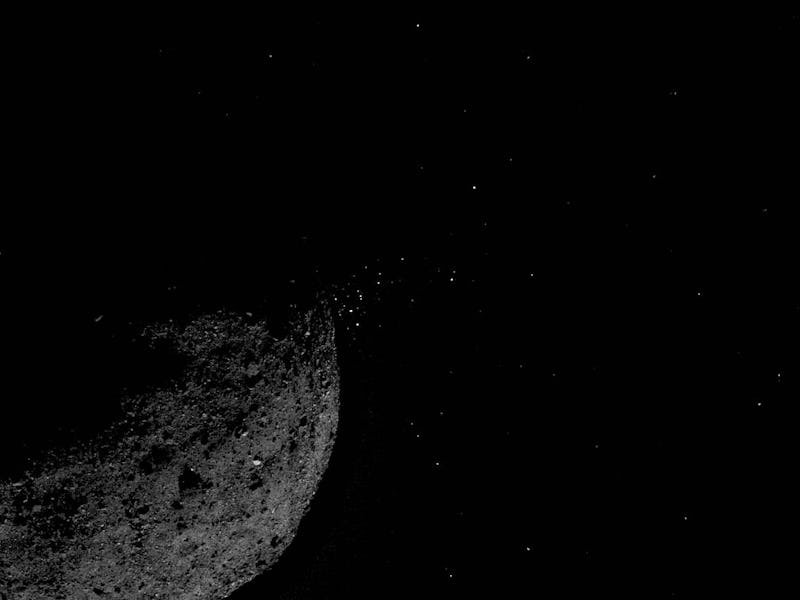Bennu: How to watch NASA blast off from a near-Earth asteroid
Osirix-REx is bidding farewell to Bennu and heading back to Earth.

On Monday, NASA’s OSIRIS-REx will begin a two-year journey home while carrying precious cargo back to Earth — a piece of an asteroid.
The small spacecraft touched down on near-Earth asteroid Bennu in October 2020 and snagged a piece of the space rock. But after two years alongside the asteroid, OSIRIS-REx must now bid farewell to Bennu and cruise its way home to drop off the samples.
OSIRIS-REx will depart the asteroid’s side on May 10 at approximately 4 p.m. Eastern. NASA will broadcast this unprecedented event live from mission control, and here’s how you can watch this spacecraft head home.
When will OSIRIS-REx depart from Bennu?
The mission control room is expected to receive confirmation that OSIRIS-REx fired its main thrusters to push off of asteroid Bennu at approximately 4:16 p.m. Eastern, with 16 minutes to account for the time it takes for data to travel from the spacecraft down to Earth.
OSIRIS-REx will fire its thrusters for about seven minutes before it begins its journey back to Earth.
When is OSIRIS-REx landing on Earth?
The journey back home will take two years, and OSIRIS-REx is aiming for where the Earth will be at that time.
- The spacecraft is essentially playing catch up with Earth, and will circle the Sun twice, traveling a distance of 1.4 billion miles.
- OSIRIS-REx’s thrusters have to change its velocity by 595 miles per hour so that its path can intersect that of Earth’s.
- The spacecraft is expected to drop off the asteroid samples at the Utah Test and Training Range on Sept. 24, 2023.
The respective orbits of Bennu and Earth, which demonstrates how OSIRIS-REx will be able to intersect with Earth eventually while using a minimum of fuel.
How to watch OSIRIS-REx journey to Earth?
NASA will broadcast OSIRIS-REx’s departure from Bennu live on NASA-TV, the NASA app, and the agency’s website.
The broadcast will begin at 4 p.m. Eastern.
You can also follow along the journey on NASA’s social media platforms through Instagram, Twitter, and Facebook.
THE OSIRIS-REX MISSION GOALS
OSIRIS-REx launched from Earth on September 8, 2016, carrying six instruments designed to map the asteroid, document the sample site, and make other observations of Bennu.
The mission marked NASA's first attempt to land on an asteroid and return a sample of one of these curious bodies back to Earth.
- Bennu orbits the Sun every 436.6 days.
- It is a rare, B-type asteroid — the most primitive kind of asteroid.
- Bennu has barely changed since it formed 4 billion years ago, and it contains relatively high amounts of carbon, organic molecules, and amino acids — considered to be the building blocks of life.
After touching down on Bennu on October 20, 2020, OSIRIS-REx grabbed more than 2.1 ounces of asteroid material from the rocky body and secured them in a capsule.
The spacecraft's sampling head touched Bennu’s surface for approximately 6 seconds, before backing away from the asteroid. By penetrating Bennu's regolith and firing a nitrogen-gas bottle to stir up some of the dust and pebbles on the asteroid's surface, the spacecraft could scoop up the surface material.
The spacecraft’s sample capsule will travel through Earth’s atmosphere and land with parachutes at the Utah Test and Training Range.
After recovering the capsule, team members will transport it to the curation facility at NASA’s Johnson Space Center in Houston.
The agency will then distribute the sample to laboratories worldwide so that a large group of international scientists can simultaneously study pieces of the asteroid.
Unaltered asteroid samples are critical to understanding our origins. Scientists believe that asteroids are made up of the same ancient material that formed the Solar System billions of years ago.
"The reason there’s so much interest in asteroids is a lot of them are very primitive, from when the Solar System formed, and they didn't change with wind and water, or weather like on Earth," Amy Simon, a planetary scientist at NASA's Goddard Space Flight Center, told Inverse in an interview in October. "They're still more pristine than anything you could find in the universe."
Studying asteroids provides us with clues on how planets, including Earth, came to exist.
This article was originally published on